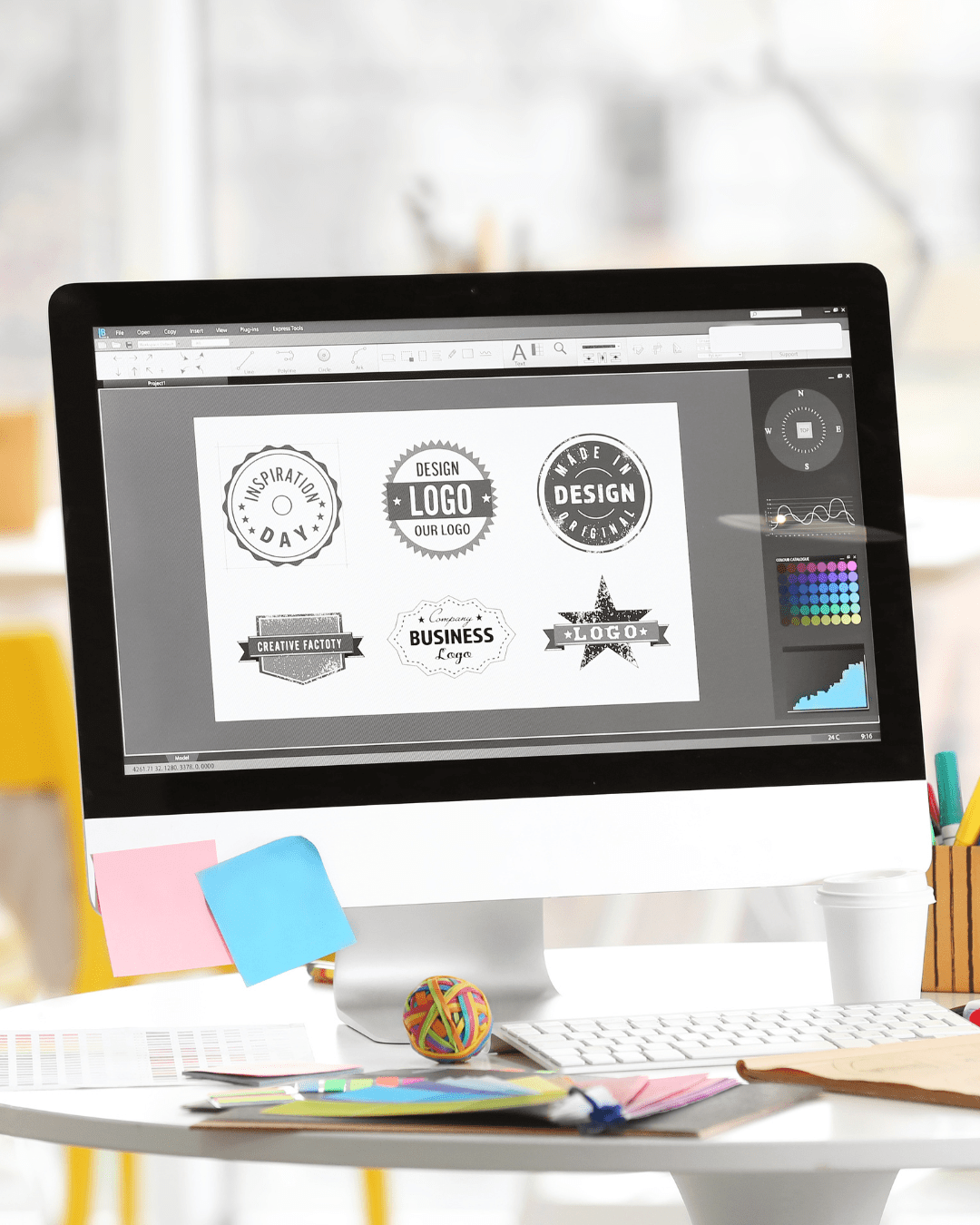
When you think of a brand, what’s the first thing that comes to mind?
Maybe it’s the swoosh of Nike, the golden arches of McDonald’s, or the sleek Apple logo.
But here’s the thing: a logo alone doesn’t make a brand. It’s the brand elements that work together to create recognition, trust, and loyalty over time.
Think of brand elements as the building blocks that shape how your brand communicates with the world.
The logo might be the face of your brand, but there’s so much more that goes into establishing a lasting, impactful brand.
If you want to go beyond the basics and build a brand that people recognize and trust, you need to understand the other crucial brand elements that make it all come together.
What Are Brand Elements?
So, what exactly are brand elements?
Simply put, they’re the various components that come together to form your brand’s identity.
These include your logo, color scheme, typography, voice, messaging, and even how your brand feels to your audience. Every detail you include in your brand, from the visual to the emotional, falls under the umbrella of brand elements.
While your logo is a key visual representation, it’s only one part of the puzzle.
Think of your brand’s identity as a multi-layered cake—each brand element adds flavor, texture, and personality that makes the whole thing memorable.
What Are the Five Elements That Make a Strong Brand?
You might be wondering, what exactly are the brand elements that create a strong, recognizable brand?
Well, there are five core elements that are essential for any brand aiming to stand out and build a strong identity:
- Logo: Yes, it’s the big one. Your logo is the face of your brand and should be simple, memorable, and easily recognizable. But it’s not the whole story—it’s just the starting point.
- Color Palette: Colors aren’t just about aesthetics—they evoke emotions and set the tone. Ever noticed how red can make you feel energized, while blue feels calming and trustworthy? Choosing the right color palette is one of the most powerful brand elements.
- Typography: The fonts you use tell a story. Serif fonts may feel traditional and reliable, while sans-serif fonts are modern and clean. Choose fonts that align with your brand’s voice and personality.
- Voice & Messaging: The tone of your brand’s language speaks volumes. Are you playful, formal, or authoritative? The words you choose, how you phrase things, and the consistency of your messaging form an important part of your brand elements.
- Imagery & Graphics: The visuals you use in marketing materials, websites, and social media shape how your audience perceives your brand. Whether it’s photography, illustrations, or icons, your imagery should align with your brand’s values and message.
These five brand elements work together like a well-rehearsed band—each one plays its part in creating a harmonious, unified brand experience.
What Are the Five Elements of Visual Branding?
When it comes to building brand recognition, visual branding is one of the most powerful tools you have in your arsenal.
But what exactly makes up visual branding? It’s more than just a logo. Here are the five key brand elements of visual branding:
- Logo: We’ve already touched on this, but it’s worth repeating. Your logo is the cornerstone of your visual brand. It’s how people will first recognize you. Make sure it’s memorable, versatile, and unique.
- Typography: The fonts you choose should reflect your brand’s personality. Are you modern and minimal, or elegant and sophisticated? Typography is an often-overlooked brand element that can really set you apart.
- Color Scheme: Colors are powerful. They have the ability to create an emotional connection with your audience. Your color palette should not only reflect your brand values but also be consistent across all platforms for maximum impact.
- Imagery: The style of images you use—whether photographs, illustrations, or even abstract designs—can communicate a lot about your brand. Consistency in your imagery ensures that your brand feels cohesive across all touchpoints.
- Design Patterns: These are the subtle design elements that can give your brand a unique flavor, such as icons, borders, and texture patterns. These elements tie together your visual language and give your brand a distinctive look.
Every one of these visual brand elements should work together to create a cohesive, easily recognizable brand identity that speaks to your audience.
What Are the Six Criteria for Brand Elements?
You might be wondering, what makes a brand element effective?
After all, there’s a lot of thought that goes into choosing the right colors, fonts, and logos. Here are six criteria that will help you evaluate whether your brand elements are up to the task:
- Memorability: Can your audience easily recall your brand after encountering it? The best brand elements are simple, distinctive, and easy to remember.
- Meaningfulness: Do your brand elements convey the right message about who you are and what you stand for? Each component should help tell your brand’s story.
- Likeability: Does your brand have an appealing vibe? Whether it’s your logo or your messaging, your brand elements should be likable and relatable to your target audience.
- Transferability: Can your brand elements work across various platforms, from your website to social media to print materials? Your elements should be versatile enough to maintain their impact across different mediums.
- Adaptability: As trends and times change, your brand elements should be flexible enough to evolve without losing their core identity. Think of how companies refresh their logos over time—they tweak, but don’t completely change.
- Protectability: Is your brand legally protected? Can you trademark your logo or slogan? This is a critical element to consider when developing your brand elements to ensure you can safeguard your brand’s identity.
These six criteria are your checklist for ensuring that your brand elements not only look good but are also functional and lasting.
What Is Visual Branding?
Now, let’s dive a little deeper into visual branding.
You may have heard this term tossed around a lot, but what exactly does it mean? Simply put, visual branding is the use of visuals—logos, colors, fonts, images, and design elements—to communicate your brand’s identity and values.
But why is visual branding so important?
Because humans process visuals 60,000 times faster than text. That means the right visual elements can leave a lasting impression in just seconds.
If your brand elements are strong, your audience will associate those visuals with your brand message, even if they don’t consciously realize it.
What Is Vision in Branding?
Finally, let’s talk about vision.
What is vision in branding, and why should you care? Your vision is your brand’s “why”—the reason your company exists beyond just making a profit.
It’s what drives you and helps shape how you communicate with your audience.
Your brand elements should reflect this vision. If your vision is about creating sustainability, for example, your brand elements might include earthy tones, minimalistic design, and eco-friendly messaging.
Every element—from your logo to your voice—should align with this core purpose.
Final Thoughts
Building a strong brand isn’t just about having a cool logo.
It’s about understanding the brand elements that make up your identity and how they work together to build trust, recognition, and loyalty with your audience.
From your logo and color palette to your messaging and voice, every brand element should reflect your vision and communicate your values.
By paying attention to these details, you’ll create a brand that’s not only memorable but also authentic and trustworthy.
So go ahead—dig into your brand elements, and make sure they’re doing their job to build something that resonates with your audience.
Related Articles: Starting Your Private Practice
How to Reach Your Target Audience (Without Losing Your Mind)
Where Is Your Target Audience Hiding?Let's find them without losing your mind or wasting anymore time! So, you’ve got the service, the product, or the big idea—yay, you! Now comes the fun (and sometimes slightly confusing) part: figuring out how to reach your target...
Google Ads For Therapists: The Ultimate Guide to Paid Google Ads for Therapists
Google Ads For TherapistThe Ultimate Guide to Google Ads for Therapists & Mental Health ProfessionalsAlright, folks, let's cut to the chase. You're here because you've realized that being a fantastic therapist isn't quite enough in the digital age. You need to be...
Marketing to Gen Z
How to Market to Gen ZMarketing Mental Healthcare Services & Products to Gen Z: Tailoring Your Approach for the Next GenerationWho is Gen Z?Gen Z, the group born from the mid-1990s to the early 2010s, is stepping into adulthood and reshaping the market with their...
Introverts in Digital Marketing: Low-Effort Strategies for Growth
In the digital marketing's perpetual roar, introverts often seek strategies that whisper, not shout. This blog sheds light on marketing gems for the quietly impactful: from the serene sanctuary of blogging to the stealthy power of SEO. Forget exhausting, extroverted...
Rebranding Your Practice: Updating Your Online Presence
Advice for Therapist Branding: A Guide to Refreshing Your Online Presence In today's digital world, your online presence serves as the first impression for potential clients. For therapists, this digital introduction is crucial in conveying the trust and...
How to Convert More Leads
You've got leads coming in... now what? Seven (7) Tips for Converting Leads Advice from a Digital Agency specializing in Mental Health.Congratulations! Your mental and behavioral healthcare company has successfully generated leads and potential clients are expressing...
THE LMR PAID ADS GUIDE – Get a Head Start with This Paid Internet Advertising Guide
Follow this Google Ad Guide to Maximize Your Budget! Internet advertising has grown in popularity in recent years, and it has become a necessity for companies that wish to target a specific audience.Long gone are the days when you would place an ad in the newspaper...
Why Personal Branding Matters More Than Ever for Therapists in 2025
Let’s face it—the world is noisier than ever. With social media feeds overflowing and more therapists entering private practice, standing out in 2025 is no longer just about having credentials or a cozy office. It’s about branding. And not just any branding—personal...
SEO for Therapists in 2025: The New Best Practices for Ranking Higher
If you’re a therapist trying to navigate the wild world of digital marketing, you already know that standing out online can feel like a therapy session in itself—full of highs, lows, and the occasional existential crisis. But don’t worry, we’ve got you covered. ...
Website Design Trends for Mental Health Practices in 2025: What’s In and What’s Out
Let’s face it—the days of sterile, cookie-cutter websites are long gone. In 2025, mental health practices are stepping into a new digital era, where bold aesthetics meet seamless user experience. At LMR Digital, we’ve been right in the thick of it, helping our mental...
Helping businesses from the west to east coast, and everything in between!
Follow Us On Instagram!
Helpful Page Links
LMR Digital Marketing
Digital Marketing Services for Healthcare & Other Service Based Companies. Reach out today to see if we are a good fit.
Who We Help
- Applied Behavior Analysis Companies
- Group Therapy Practices
- Rehab Centers
- Telehealth Companies
- EHR and other Saas Companies
- Speech Therapy Practices
- Medical Practices
- Psychiatric & Medication Management










